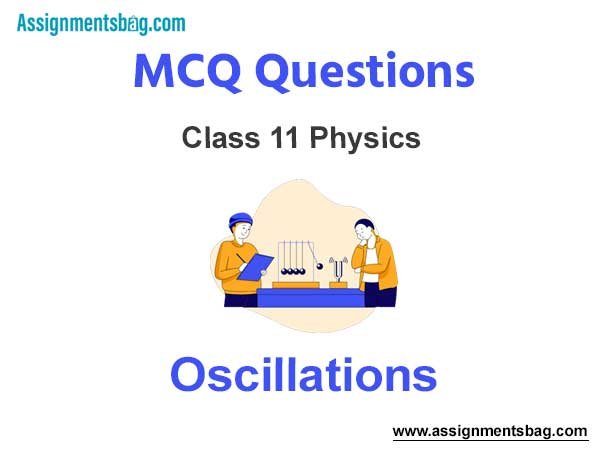Please refer to MCQ Questions Chapter 14 Oscillations Class 11 Physics with answers provided below. These multiple-choice questions have been developed based on the latest NCERT book for class 11 Physics issued for the current academic year. We have provided MCQ Questions for Class 11 Physics for all chapters on our website. Students should learn the objective based questions for Chapter 14 Oscillations in Class 11 Physics provided below to get more marks in exams.
Chapter 14 Oscillations MCQ Questions
Please refer to the following Chapter 14 Oscillations MCQ Questions Class 11 Physics with solutions for all important topics in the chapter.
MCQ Questions Answers for Chapter 14 Oscillations Class 11 Physics
Question. A particle executes linear simple harmonic motion with an amplitude of 3 cm. When the particle is at 2 cm from the mean position, the magnitude of its velocity is equal to that of its acceleration. Then its time period in seconds is

Answer
B
Question. A particle of mass m oscillates along x-axis according to equation x = a sin ϖt. The nature of the graph between momentum and displacement of the particle is
(a) straight line passing through origin
(b) circle
(c) hyperbola
(d) ellipse
Answer
D
Question. The displacement of a particle is represented by the equation y = sin3 ϖt. The motion is
(a) non-periodic
(b) periodic but not simple harmonic
(c) simple harmonic with period 2p/w
(d) simple harmonic with period p/w
Answer
B
Question. A body of mass m falls from a height h onto a pan (of negligible mass) of a spring balance as shown. The spring also possesses negligible mass and has spring constant k. Just after striking the pan, the body starts socillatory motion in vertical directioin of amplitude A and energy E. Then

Answer
B
Question. On Earth, a body suspended on a spring of negligible mass causes extension L and undergoes oscillations along length of the spring with frequency f. On the Moon, the same quantities are L/n and f ‘ respectively. The ratio f ‘/f is
(a) n
(b) n/1
(c) n–1/2
(d) 1
Answer
D
Question. A pendulum bob is raised to a height h and released from rest. At what height will it attain half of its maximum speed?
(a) 3h/4
(b) h/2
(c) h/4
(d) h 0.707
Answer
A
Question. A Second’s pendulum is placed in a space laboratory orbiting around the earth at a height 3 R from the earth’s surface where R is earth’s radius. The time period of the pendulum will be
(a) zero
(b) 2√3
(c) 4 sec
(d) infinite
Answer
D
Question. A particle undergoes simple harmonic motion having time period T. The time taken in 3/8th oscillation is

Answer
C
Question. Two oscillators are started simultaneously in same phase. After 50 oscillations of one, they get out of phase by p, that is half oscillation. The percentage difference of frequencies of the two oscillators is nearest to
(a) 2%
(b) 1%
(c) 0.5%
(d) 0.25%
Answer
B
Question. Two particles are oscillating along two close parallel straight lines side by side, with the same frequency and amplitudes. They pass each other, moving in opposite directions when their displacement is half of the amplitude. The mean positions of the two particles lie on a straight line perpendicular to the paths of the two particles. The phase difference is
(a) 0
(b) 2π/3
(c) π
(d) π/6
Answer
B
Question. The length of a second’s pendulum at the surface of earth is 1 m. The length of second’s pendulum at the surface of moon where g is 1/6th that at earth’s surface is
(a) 1/6 m
(b) 6 m
(c) 1/36 m
(d) 36 m
Answer
A
Question. A body of mass 5 gram is executing S.H.M. about a fixed point O. With an amplitude of 10 cm, its maximum velocity is 100 cm/s. Its velocity will be 50 cm s–1 at a distance (in cm)
(a) 5
(b) 5√2
(c) 5√3
(d) 10√2
Answer
C
Question. The total mechanical energy of a spring-mass system in simple harmonic motion is E = 1/2 mϖ2 A2. Suppose the oscillating particle is replaced by another particle of double the mass while the amplitude A remains the same. The new mechanical energy will
(a) become 2E
(b) become E/2
(c) become √2E
(d) remain E
Answer
D
Question. A particle executing simple harmonic motion along y-axis has its motion described by the equation y = Asin(ϖt) + B . The amplitude of the simple harmonic motion is
(a) A
(b) B
(c) A + B
(d) √A+ B
Answer
A
Question. An instantaneous displacement of a simple harmonic oscillator is x = A cos (wt + p/4). Its speed will be maximum at time
(a) π/4 ϖ
(b) π/2 ϖ
(c) π/ϖ
(d) 2 π/ϖ
Answer
A
Question. A simple pendulum has a metal bob, which is negatively charged. If it is allowed to oscillate above a positively charged metallic plate, then its time period will
(a) increase
(b) decrease
(c) become zero
(d) remain the same
Answer
B
Question. Which of the following is a simple harmonic motion?
(a) Particle moving through a string fixed at both ends.
(b) Wave moving through a string fixed at both ends.
(c) Earth spinning about its axis.
(d) Ball bouncing between two rigid vertical walls.
Answer
B
Question. A rod is hinged vertically at one end and is forced to oscillate in a vertical plane with hinged end at the top, the motion of the rod:
(a) is simple harmonic
(b) is oscillatory but not simple harmonic
(c) is pericolic but not oscillatory
(d) may be simple harmonic
Answer
D
Question. A pendulum is undergoing S.H.M. The velocity of the bob in the mean position is v. If now its amplitude is doubled, keeping the length same, its velocity in the mean position will be
(a) v/2
(b) v
(c) 2 v
(d) 4 v
Answer
C
Question. The tension in the string of a simple pendulum is
(a) constant
(b) maximum in the extreme position
(c) zero in the mean position
(d) None of these
Answer
D
Question. Resonance is an example of
(a) tuning fork
(b) forced vibration
(c) free vibration
(d) damped vibration
Answer
B
Question. The displacement of aparticle along the x-axis is given by x = a sin2 wt. The motion of the particle corresponds to:
(a) simple harmonic motion of frequency w/ π
(b) simple harmonic motion of frequency 3w/ 2π
(c) non simple harmonic motion
(d) simple harmonic motion of frequency w/ 2π
Answer
A
Question. A mass M is suspended from a spring of negligible mass. The spring is pulled a little and then released so that the mass executes SHM of time period T. If the mass is increased by m, the time period becomes 5T/3 . Then the ratio of M/m is
(a) 25/9
(b) 16/9
(c) 5/3
(d) 3/5
Answer
B
Question. The displacement of a S.H.M. doing particle when K.E. = P.E. (amplitude = 4 cm) is

Answer
A
Question. If a simple pendulum of length l has maximum angular displacement θ, then the maximum K.E. of bob of mass m is
(a)1/2 ml / g
(b) mg/ 2l
(c) mgl(1- cos θ)
(d) mgl sin θ/2
Answer
C
Question. Two wires are kept tight between the same pair of supports. The tensions in the wires are in the ratio 2 : 1, the radii are in the ratio 3 : 1 and the densities are in the ratio 1 : 2. The ratio of their fundamental frequencies is
(a) 2 : 3
(b) 2 : 4
(c) 2 : 5
(d) 2 : 6
Answer
A
Question. Two particles are executing S.H.M. of same amplitude and frequency along the same straight line path. They pass each other when going in opposite directions, each time their displacement is half of their amplitude. What is the phase difference between them ?
(a) 5 π/6
(b) 2 π/3
(c) π/3
(d) π/6
Answer
B
Question. A simple pendulum attached to the roof of a lift has a time period of 2s in a stationary lift. If the lift is allowed to fall freely the frequency of oscillations of pendulum will be
(a) zero
(b) 2 Hz
(c) 0.5 Hz
(d) infinity
Answer
A
Question. A mass m fall on spring of spring constant k and negligible mass from a height h. Assuming it sticks to the pan and executes simple harmonic motion, the maximum height upto which the pan will rise is

Answer
B
Question. A particle of mass is executing oscillations about the origin on the x-axis. Its potential energy is V(x) = k | x |3, where k is a positive constant. If the amplitude of oscillation is a, then its time period T is
(a) proportional to 1/√a
(b) proportional to √a
(c) independent 3/a 2
(d) None of these
Answer
A
Question. A coin is placed on a horizontal platform which undergoes vertical simple harmonic motion of angular frequency w. The amplitude of oscillation is gradually increased. The coin will leave contact with the platform for the first time
(a) at the mean position of the platform
(b) for an amplitude of g/ϖ2
(c) for an amplitude of g2/ϖ2
(d) at the highest position of the platform
Answer
B
Question. The relation between acceleration and displacement of four particles are given below
(a) ax = +2x
(b) ax = +2x2
(c) ax = –2x2
(d) ax = –2x
Which, one of the particle is exempting simple harmonic motion?
Answer
D
Question. The oscillation of a body on a smooth horizontal surface is represented by the equation,
X = A cos (ϖt)
where X = displacement at time t
ϖ = frequency of oscillation
Which one of the following graphs shows correctly the variation of ‘a’ with ‘t’?

Answer
C
Question. A spring of force constant k is cut into lengths of ratio 1 : 2 : 3. They are connected in series and the new force constant is k’. Then they are connected in parallel and force constant is k¢¢ . Then k’ : k¢¢ is
(a) 1 : 9
(b) 1 : 11
(c) 1 : 14
(d) 1 : 6
Answer
B

We hope you liked the above provided MCQ Questions Chapter 14 Oscillations Class 11 Physics with solutions. If you have any questions please ask us in the comments box below.


